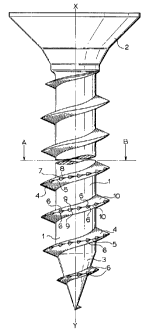Some of the information on this Web page has been provided by external sources. The Government of Canada is not responsible for the accuracy, reliability or currency of the information supplied by external sources. Users wishing to rely upon this information should consult directly with the source of the information. Content provided by external sources is not subject to official languages, privacy and accessibility requirements.
Any discrepancies in the text and image of the Claims and Abstract are due to differing posting times. Text of the Claims and Abstract are posted:
| (12) Patent: | (11) CA 2015382 |
|---|---|
| (54) English Title: | THREAD-CUTTING SCREW |
| (54) French Title: | VIS AUTOTARAUDEUSE |
| Status: | Expired |
| (52) Canadian Patent Classification (CPC): |
|
|---|---|
| (51) International Patent Classification (IPC): |
|
| (72) Inventors : |
|
| (73) Owners : |
|
| (71) Applicants : |
|
| (74) Agent: | SMART & BIGGAR |
| (74) Associate agent: | |
| (45) Issued: | 2001-05-22 |
| (22) Filed Date: | 1990-04-25 |
| (41) Open to Public Inspection: | 1990-10-25 |
| Examination requested: | 1996-05-02 |
| Availability of licence: | N/A |
| (25) Language of filing: | English |
| Patent Cooperation Treaty (PCT): | No |
|---|
| (30) Application Priority Data: | ||||||
|---|---|---|---|---|---|---|
|
A thread forming screw has a shaft with a head and
a tip at opposite ends of the shaft. The screw also has a
thread which starts at the tip and runs at least partially
along the shaft towards the head of the screw. The thread
has first and second opposing flanks facing the tip and the
head of the screw respectively. The thread, at least at
the tip of the screw, has recesses in at least the first
flank thereof. The recesses, which form undulations in the
thread have upper borders which form an edge on the thread
and are asymmetrical with a deeper front face and a
shallower rear mace in screw in direction of the thread.
Note: Claims are shown in the official language in which they were submitted.
Note: Descriptions are shown in the official language in which they were submitted.

For a clearer understanding of the status of the application/patent presented on this page, the site Disclaimer , as well as the definitions for Patent , Administrative Status , Maintenance Fee and Payment History should be consulted.
| Title | Date |
|---|---|
| Forecasted Issue Date | 2001-05-22 |
| (22) Filed | 1990-04-25 |
| (41) Open to Public Inspection | 1990-10-25 |
| Examination Requested | 1996-05-02 |
| (45) Issued | 2001-05-22 |
| Expired | 2010-04-25 |
There is no abandonment history.
Note: Records showing the ownership history in alphabetical order.
| Current Owners on Record |
|---|
| ROMMEL, ERWIN |
| Past Owners on Record |
|---|
| DICKE, ROBERT |